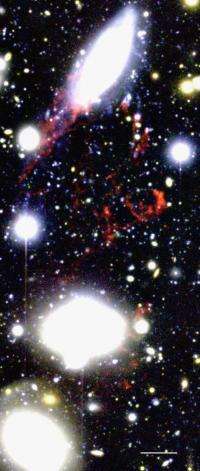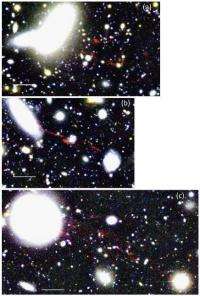Why do the ionized gas clouds stream out from galaxies?

Using the Subaru Prime Focus Camera (Suprime-Cam) in their observations of the Coma Cluster, researchers from the National Astronomical Observatory of Japan (NAOJ), Hiroshima University, the University of Tokyo, and other institutes have discovered 14 galaxies accompanied by extended, ionized hydrogen clouds.
The discovery marks the first time that scientists have detected many galaxies with extended ionized hydrogen gas clouds in a cluster and investigated their spatial and velocity distribution as well as the characteristics of their parent galaxies. The observations captured images of this cluster of galaxies during a critical moment of galaxy evolution and contribute to an understanding of how such clouds may have formed.
A cluster of galaxies is an aggregate of a few to hundreds or even thousands of galaxies. Scientists know that more elliptical (E) and lenticular (S0) galaxies exist more often in cores of clusters of galaxies than in less dense environments. The elliptical and lenticular galaxies are called as "quiescent galaxies" because they show no star formation activity. Meanwhile, spiral galaxies such as our Galaxy are still undergoing star formations, and they are likely to reside in less populated regions. These attributes of clusters raise a number of important questions about the evolution of galaxies: "What kind of mechanisms shape these variety of galaxies occurring in different environments?" and "Why do clusters of galaxies contain many galaxies that do not form stars?" The current research provides observational evidence that addresses these issues.
The team focused their observations on the Coma Cluster, a large cluster of more than 3,000 galaxies and one of the nearest (about 300 billion light years away) clusters to our Galaxy. Past observations had found several extended ionized hydrogen clouds associated with galaxies in the cluster. This group of scientists concentrated on examining these clouds and used a special filter in their observations to catch a specific spectral line (the H-alpha line) created by ionized hydrogen at a particular wavelength. Consequently, they detected 14 galaxies with extended ionized hydrogen clouds, examples of which are shown in Figures 1 and 2.
Most of the ionized hydrogen gas appears as if it was ejected from the galaxy. Follow up observations with Subaru's Faint Object Camera and Spectrograph (FOCAS) confirmed that some of the gas clouds have a recession velocity comparable to that of adjacent galaxies. Therefore, the scientists infer that the overlap between the gas and the galaxy did not occur by chance but resulted from the gas streaming out of the galaxy.

A more detailed investigation of the ionized hydrogen clouds and their "parent galaxies" reveals that most of the parent galaxies are currently or were recently forming stars. In addition, most parent galaxies have a relatively large velocity difference (more than 1000 km/s) when compared with the average recession velocity of the Coma Cluster. These observational results suggest that the extended ionized hydrogen gas was probably stripped from the parent galaxies by either interaction with the hot gas of the cluster or by the tidal force of the cluster produced when the parent galaxies are trapped by the gravity of the cluster and fall onto the cluster. This scenario predicts a difference in star formation between low and high mass galaxies. Low mass galaxies that lose all of their gas from stripping cease star formation, while higher mass galaxies retain their gas and continue to form stars. The correlation between mass and star-forming activity derived from the observations in the team's research confirms the prediction.
In summary, this study has clarified some of the specific conditions under which extended ionized hydrogen clouds were formed as well as the relationship between the conditions and characteristics of the parent galaxies. Nevertheless, questions remain. How is the stripped gas ionized, and how does it retain the H-alpha emission? The most distant ionized gas cloud lies 300,000 light years from the parent galaxy, and it would take 100 million years or more for that cloud to travel this distance. Since the brightness of the H-alpha emission of the distant clouds is comparable to the clouds near the parent galaxy, the energy to maintain the H-alpha emission must have somehow persisted for more than 100 million years. How these H-alpha emitting structures endure this long remains a mystery. What is going on in the cluster!?
The research group will conduct further spectroscopic observations to help solve this puzzle. They plan to estimate the temperature and density of several parts of the ionized hydrogen clouds and to tackle the question of how the galaxy and gas are evolving in the nearby cluster of galaxies.
More information: The research on which this article is based will be published in the December 2010 issue of the Astronomical Journal (140:1814-1829): "A Dozen New Galaxies Caught in the Act: Gas Stripping and Extended Emission Line Regions in the Coma Cluster" by M. Yagi et al.
Provided by Subaru Telescope




















